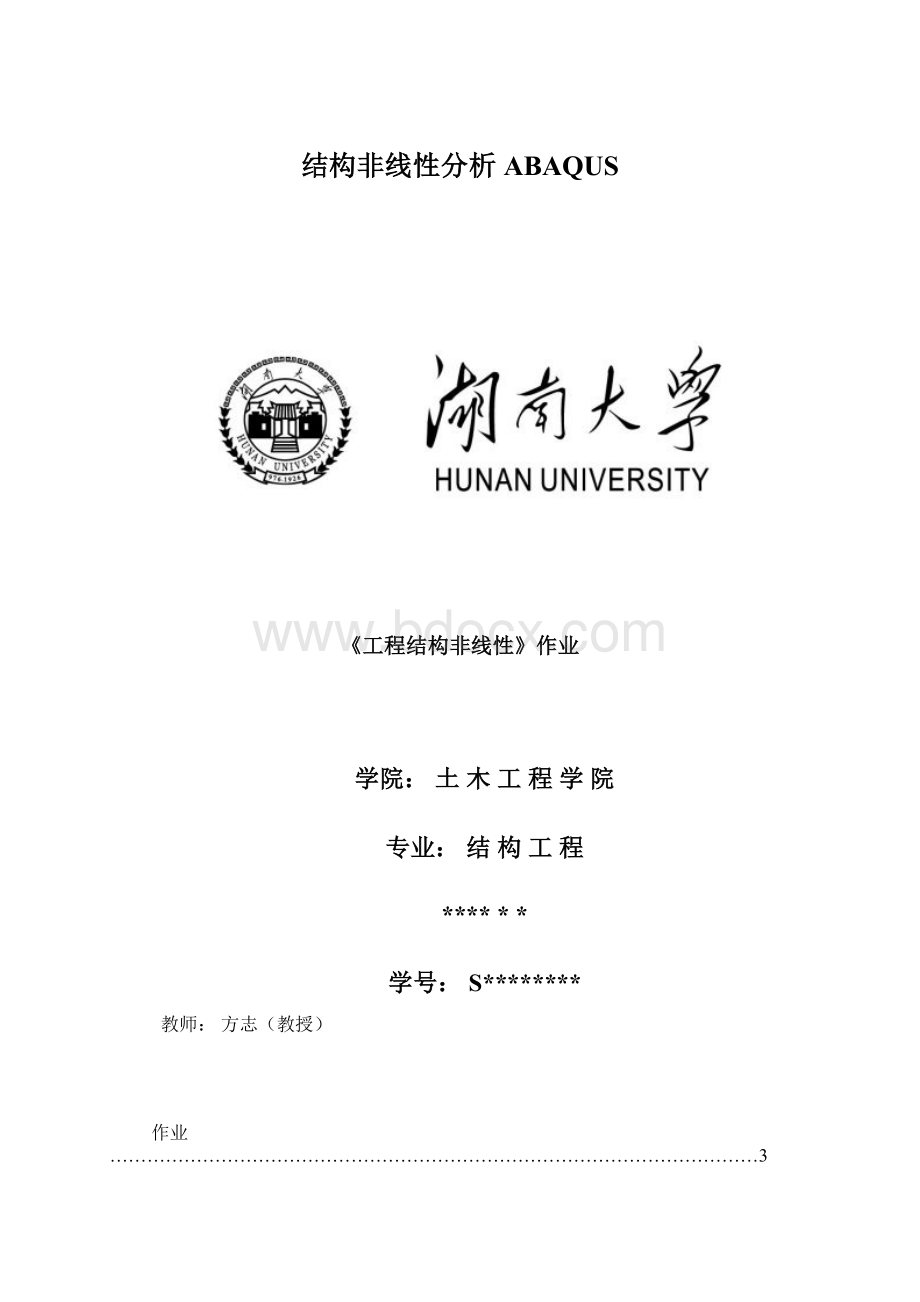结构非线性分析ABAQUSWord文档下载推荐.docx
《结构非线性分析ABAQUSWord文档下载推荐.docx》由会员分享,可在线阅读,更多相关《结构非线性分析ABAQUSWord文档下载推荐.docx(23页珍藏版)》请在冰豆网上搜索。

2.4模拟结果分析对比…………………………………………………………………………12
3ABAQUS有限元软件分析的理论背景(来自ABAQUS帮助文件)………………………14
4对结构几何非线性和稳定的关系进行讨论…………………………………………………24
结构非线性作业一
(1)求出荷载——柱中点侧移的解析解。
(2)以具体的实例给出几何非线性效应得数值解(可用有限元程序计算),并与解析解结果对比。
(3)给出有限元程序理论背景的详细描述。
(4)对结构几何非线性和稳定的关系进行讨论。
1偏压柱的跨中最大挠度的解析解
图1计算简图
1.1跨中弯矩为:
(1)
1.2由材料力学中梁挠曲线的近似微分方程可以得到:
将
(1)式代入其中得
解微分方程得:
其中
1.3求跨中侧移:
当
时
2用有限元软件ABAQUS建立题中所给的弯压柱的力学模型,并计算跨中最大挠度
2.1给出一个实例:
假设题中所给弯压柱所受荷载P=10KN,偏心距e=0.1m,柱高为L=2m,采用屈服强度为345MP的钢材,弹性模量E=206000MP,柱的截面尺寸如所示:
2.2确定材料的本构模型
采用韩林海(2007)中的二次塑性流模型来模拟钢材,其应力-应变关系曲线,分为弹性段(Oa)、弹塑性段(ab)、塑性段(bc)、强化段(cd)和二次塑流(de)等五个阶段,如图1所示。
图1中的点划线为钢材实际的应力-应变关系曲线,实线所示为简化的应力-应变关系曲线,模型的数学表达式如式(3-1)。
其中:
;
fp、fy和fu分别为钢材的比例极限、屈服极限和抗拉强度极限。
(3-1)
由该本构模型计算出材料的应力—应变关系
表1 计算的钢管的力学参数与应力——应变曲线
应
变
分
段
点
0.001729612
0.001383689
0.002075534
0.02075534
0.218143
系
数
A
1.48877E+14
B
6.18E+11
C
-285040000
2.3建立有限元模型
2.3.1创建部件
在ABAQUS里打开而为建模截面,创建一根二维的柱模型,长度为2000mm。
如下图所示:
图1创建二维柱部件
2.3.2创建材料参数
创建钢材料属性采用韩林海(2007)二次塑流模型Ec=206000;
泊松比0.3;
塑性应力应变参数见表格;
同时要对材料的的塑性性能进行编辑,将事先计算好的应力——塑性应变数据导入到steel的塑性编辑表格里面去就可以了。
在输入材料的应力—塑性应变数据组的时候要保证所输入的塑性应变是递增的,并且初始塑性应变必须为零。
将塑性数据输入到软件中去。
表2钢材塑性应变——应力
应力
塑性应变
276
345
0.0152
300.84
0.0171
320.16
0.0001
0.019
333.96
386.4
0.056
342.24
0.0002
427.8
0.0931
0.0003
469.2
0.1301
0.0022
510.6
0.1672
0.0041
552
0.2042
0.0059
0.2249
0.0078
0.2456
0.0097
0.2663
0.0115
0.287
0.0134
0.3077
图2创建钢材材料属性
2.3.3创建并指派截面
指派截面定义柱的截面为一个宽50mm,高100mm的矩形截面如下:
图3创建柱界面并赋予构件上
2.3.4组装配件
将各个部件建立起来并赋予了材料属性与截面属性之后,开始将各个部件组装在一起。
Instancepart选择需组装的部件。
图4装配构件
2.3.5设置分析步与相互作用
在本模型中需要研究的是跨中挠度。
所以在设置分析步中的历程输出中要创建相应的输出。
为了便于计算机计算模型,需要创建一个分析步。
需要输出的数据为跨中挠度。
图5(a)设置分析步
图5(b)设置分析步参数
2.3.6创建荷载,约束并划分网格
构件受到一个偏心的轴力的作用,在这里假设柱受到一个轴力P=10KN,和一对弯矩M=2KNM作用。
图6创建荷载划分网格
图7划分网格
2.3.7新建工作并提交运行
进入到工作界面,新建工作,新建完工作之后要进行数据检查,检查完数据无误之后
再点击提交开始运行。
运行完之后就可以在可视化对话框中观察计算结果。
2.3.8模拟结果分析
运用Abqaus6.5有限元软件建模计算之后可以得出钢管混凝土叠合柱的各个部件在既定荷载下的受力情况。
图8(a)加载前的柱图
图8(b)加载后的变形图
图13加载后的受力云图
输出跨中挠度——时间曲线
3.5结果分析
ABAQUS模拟计算出来跨中最大挠度为:
0.52561mm
利用前面建立的理论公式计算跨中挠度:
所以:
对比有限元软件结果0.52561mm与理论公式结果0.51865mm,差异度只有1.3%
4ABAQUS有限元软件分析的理论背景(来自ABAQUS帮助文件)
4.1NonlinearsolutionmethodsinAbaqus/Standard
Product:
Abaqus/Standard
ThefiniteelementmodelsgeneratedinAbaqusareusuallynonlinearandcaninvolvefromafewtothousandsofvariables.Intermsofthesevariablestheequilibriumequationsobtainedbydiscretizingthevirtualworkequationcanbewrittensymbolicallyas
where
istheforcecomponentconjugatetothe
variableintheproblemand
isthevalueofthe
variable.ThebasicproblemistosolveEquation2.2.1–1forthe
throughoutthehistoryofinterest.
ManyoftheproblemstowhichAbaquswillbeappliedarehistory-dependent,sothesolutionmustbedevelopedbyaseriesof“small”increments.Twoissuesarise:
howthediscreteequilibriumstatementEquation2.2.1–1istobesolvedateachincrement,andhowtheincrementsizeischosen.
Abaqus/StandardgenerallyusesNewton'
smethodasanumericaltechniqueforsolvingthenonlinearequilibriumequations.ThemotivationforthischoiceisprimarilytheconvergencerateobtainedbyusingNewton'
smethodcomparedtotheconvergenceratesexhibitedbyalternatemethods(usuallymodifiedNewtonorquasi-Newtonmethods)forthetypesofnonlinearproblemsmostoftenstudiedwithAbaqus.ThebasicformalismofNewton'
smethodisasfollows.Assumethat,afteraniterationi,anapproximation
tothesolutionhasbeenobtained.Let
bethedifferencebetweenthissolutionandtheexactsolutiontothediscreteequilibriumequationEquation2.2.1–1.Thismeansthat
Expandingtheleft-handsideofthisequationinaTaylorseriesabouttheapproximatesolution
thengives
If
isacloseapproximationtothesolution,themagnitudeofeach
willbesmall,andsoallbutthefirsttwotermsabovecanbeneglectedgivingalinearsystemofequations:
istheJacobianmatrixand
Thenextapproximationtothesolutionisthen
andtheiterationcontinues.
ConvergenceofNewton'
smethodisbestmeasuredbyensuringthatallentriesin
andallentriesin
aresufficientlysmall.BoththesecriteriaarecheckedbydefaultinanAbaqus/Standardsolution.Abaqus/Standardalsoprintspeakvaluesintheforceresiduals,incrementaldisplacements,andcorrectionstotheincrementaldisplacementsateachiterationsothattheusercancheckforthesecontingencieshimself.
Newton'
smethodisusuallyavoidedinlargefiniteelementcodes,apparentlyfortworeasons.First,thecompleteJacobianmatrixissometimesdifficulttoformulate;
andforsomeproblemsitcanbeimpossibletoobtainthismatrixinclosedform,soitmustbecalculatednumerically—anexpensive(andnotalwaysreliable)process.Secondly,themethodisexpensiveperiteration,becausetheJacobianmustbeformedandsolvedateachiteration.ThemostcommonlyusedalternativetoNewtonisthemodifiedNewtonmethod,inwhichtheJacobianinEquation2.2.1–2isrecalculatedonlyoccasionally(ornotatall,asintheinitialstrainmethodofsimplecontainedplasticityproblems).Thismethodisattractiveformildlynonlinearproblemsinvolvingsofteningbehavior(suchascontainedplasticitywithmonotonicstraining)butisnotsuitableforseverelynonlinearcases.(InsomecasesAbaqus/StandardusesanapproximateNewtonmethodifitiseithernotabletocomputetheexactJacobianmatrixorifanapproximationwouldresultinaquickertotalsolutiontime.Forexample,severalofthemodelsinAbaqus/StandardresultinanonsymmetricJacobianmatrix,buttheuserisallowedtochooseasymmetricapproximationtotheJacobianonthegroundsthattheresultingmodifiedNewtonmethodconvergesquitewellandthattheextracostofsolvingthefullnonsymmetricsystemdoesnotjustifythesavingsiniterationachievedbythequadraticconvergenceofthefullNewtonmethod.Inothercasestheuserisallowedtodropinterfieldcouplingtermsincoupledproceduresforsimilarreasons.)
Anotheralternativeisthequasi-Newtonmethod,inwhichEquation2.2.1–2issymbolicallyrewritten
andtheinverseJacobianisobtainedbyaniterationprocess.
Thereareawiderangeofquasi-Newtonmethods.Themoreappropriatemethodsforstructuralapplicationsappeartobereasonablywellbehavedinallbutthemostextremelynonlinearcases—thetrade-offisthatmoreiterationsarerequiredtoconverge,comparedtoNewton.WhilethesavingsinformingandsolvingtheJacobianmightseemlarge,thesavingsmightbeoffsetbytheadditionalarithmeticinvolvedintheresidualevaluations(thatis,incalculatingthe
),andinthecascadingvectortransformationsassociatedwiththequasi-Newtoniterations.Thus,forsomepracticalcasesquasi-NewtonmethodsaremoreeconomicthanfullNewton,butinothercasestheyaremoreexpensive.Abaqus/Standardoffersthe“BFGS”quasi-Newtonmethod:
itisdescribedin“Quasi-Newtonsolutiontechnique,”Section2.2.2.
Whenanyiterativealgorithmisappliedtoahistory-dependentproblem,theintermediate,nonconvergedsolutionsobtainedduringtheiterationprocessareusuallynotontheactualsolutionpath;
thus,theintegrationofhistory-dependentvariablesmustbeperformedcompletelyovertheincrementateachiterationandnotobtainedasthesumofintegrationsassociatedwitheachNewtoniteration,
.InAbaqus/Standardthisisdonebyassumingthatthebasicnodalvariables,
varylinearlyovertheincrement,sothat
represents“time”duringtheincrement.Then,foranyhistory-dependentvariable,
wecompute
ateachiteration.
Theissueofchoosingsuitabletimestepsisadifficultproblemtoresolve.Firstofall,theconsiderationsarequitedifferentinstatic,dynamic,ordiffusioncases.Itisalwaysnecessarytomodeltheresponseasafunctionoftimetosomeacceptablelevelofaccuracy.Inthecaseofdynamicordiffusionproblemstimeisaphysicaldimensionfortheproblemandthetimesteppingschememustprovidesuitablestepstoallowaccuratemodelinginthisdimension.Eveniftheproblemislinear,thisaccuracyrequirementimposesrestrictionsonthechoiceoftimestep.Incontrast,moststaticproblemshavenoimposedtimescale,andtheonlycriterioninvolvedintimestepchoiceisaccuracyinmodelingnonlineareffects.Indynamicanddiffusionproblemsitisexceptionaltoencounterdiscontinuitiesinthetimehistory,becauseinertiaorviscouseffectsprovidesmoothinginthesolution.(Oneoftheexceptionsisimpact.ThetechniqueusedinAbaqus/Standardforthisisdiscussedin“Intermittentcontact/impact,”Section2.4.2.)However,instaticcasessharpdiscontinuities(suchasbifurcationscausedbybuckling)arecommon.Softeningsystems,orunconstrainedsystems,requirespecialconsiderationinstaticcasesbutarehandlednaturallyindynamicordiffusioncases.Thus,theconsiderationsuponwhichtimestepchoiceismadearequitedifferentforthethreedifferentproblemclasses.
Abaqusprovidesboth“automatic”timestepchoiceanddirectusercontrolforallclassesofproblems.Directusercontrolcanbeusefulin